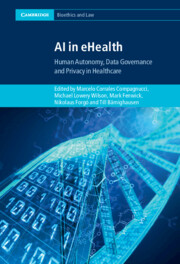Book contents
- AI in eHealth
- Cambridge Bioethics and Law
- AI in eHealth
- Copyright page
- Contents
- Contributors
- Preface
- Acronyms
- 1 Mapping the Digital Healthcare Revolution
- Part I Platforms, Apps and Digital Health
- Part II Trust and Design
- Part III Knowledge, Risk and Control
- 8 The Principle of Transparency in Medical Research
- 9 The Next Challenge for Data Protection Law
- 10 A Global Human Rights Approach to Medical Artificial Intelligence
- Part IV Balancing Regulation, Innovation and Ethics
- Index
- Cambridge Bioethics and Law
- References
8 - The Principle of Transparency in Medical Research
Applying Big Data Analytics to Electronic Health Records
from Part III - Knowledge, Risk and Control
Published online by Cambridge University Press: 08 September 2022
- AI in eHealth
- Cambridge Bioethics and Law
- AI in eHealth
- Copyright page
- Contents
- Contributors
- Preface
- Acronyms
- 1 Mapping the Digital Healthcare Revolution
- Part I Platforms, Apps and Digital Health
- Part II Trust and Design
- Part III Knowledge, Risk and Control
- 8 The Principle of Transparency in Medical Research
- 9 The Next Challenge for Data Protection Law
- 10 A Global Human Rights Approach to Medical Artificial Intelligence
- Part IV Balancing Regulation, Innovation and Ethics
- Index
- Cambridge Bioethics and Law
- References
Summary
In recent years, the amount of data provided by Electronic Health Records (EHRs) worldwide has expanded. The more data is collected, the more can be learned from it and the better decisions can be made. Projects such as InteropEHRate try to provide models on how health data can be made interoperable and available to medical research organisations. The processing of personal data might intervene with the fundamental right to data protection and/or privacy. In the EU, the GDPR treats specific forms of data processing differently if they could be protected by fundamental rights and freedoms. GDPR provides some privileges for scientific research and allows additional derogations by member states. When health data are analysed on the basis of machine learning, special attention needs to be paid to transparency, a fundamental feature in EU law that is both needed and challenged when machines, replacing or supporting humans, take decisions. This chapter analyses the principle of transparency and its compatibility with Big Data analytics in medical research. Apart from an evaluation of the current European legal framework, including Convention 108+, we will also examine global initiatives, such as the ‘Recommendation on the Protection and Use of Health-Related Data’.
Keywords
- Type
- Chapter
- Information
- AI in eHealthHuman Autonomy, Data Governance and Privacy in Healthcare, pp. 209 - 250Publisher: Cambridge University PressPrint publication year: 2022



